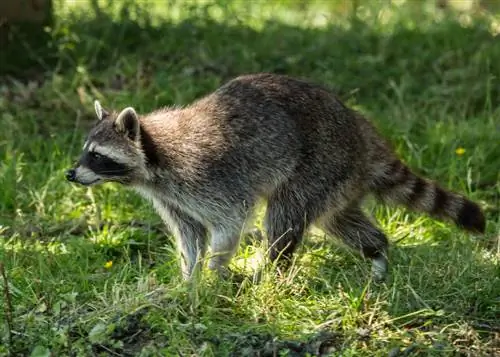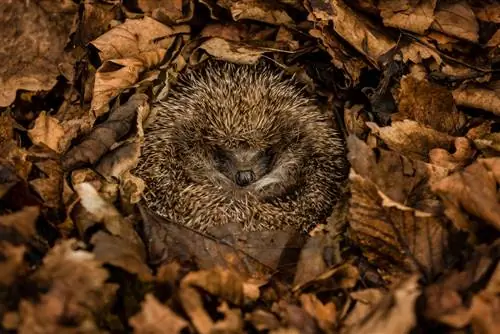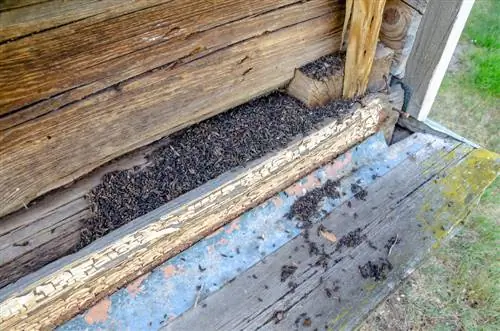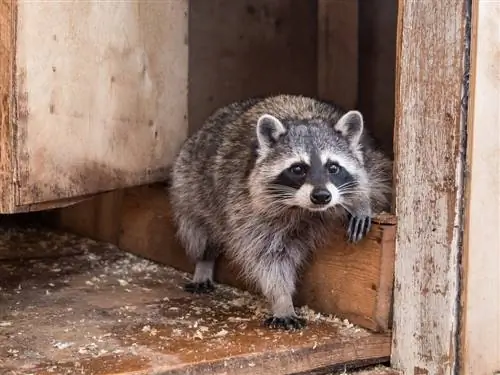- Author admin [email protected].
- Public 2023-12-16 16:46.
- Last modified 2025-01-23 11:22.
Raccoons seem to feel particularly comfortable in some attics. Their legacies accumulate over time. Homeowners don't have to sit quietly and accept the goings-on. After thorough cleaning, protective measures help to keep the unwanted guest away permanently.

How do you recognize raccoon poop?
Raccoon poop varies depending on food and season, but typically contains indigestible seeds and hair. It resembles the feces of small dogs and is left in permanent toilet areas called latrines. Caution: Raccoon feces may be contaminated with roundworm eggs and larvae.
What does raccoon poop look like?
The remains of small bears have a typical appearance to the trained eye. As a layperson, identifying the culprit is more of a challenge. Pictures of raccoon droppings can help with the search. But the environment in which you find the piles also provides clues.
Food
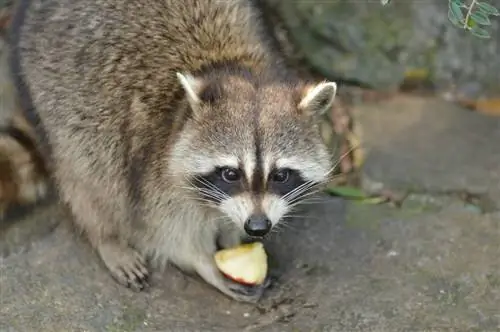
In the fall, raccoons eat more fruit and nuts
Which indigestible residue remains in the raccoon's feces depends on the food eaten. The diet of these small bears is based on the seasonal offerings. In spring, mainly worms, beetles and other insects are eaten, while in autumn, high-calorie foods such as nuts and fruit are preferred to cover the nutritional needs.
Raccoons are omnivores:
- Invertebrates: 40 percent
- Plants: 33 percent
- Vertebrates: 27 percent
Recognize and differentiate
The solution from raccoons can be found in so-called latrines. These are preferably erected in elevated places like stacked firewood. Thick branches are an optimal latrine location, which is usually shared by several raccoons. Raccoon droppings are reminiscent of the droppings of a small dog. In the fall, indigestible seeds such as cherry or sunflower seeds are often visible. In addition to a pungent smell, hair is typical of the remains. The first clues to the culprit are provided by special habits:
| typical habit | Coloring | |
|---|---|---|
| Raccoon | frequently used toilet space | variable shades of brown |
| Dog | avoid raised areas | variable, often brown |
| Cat | Feces are buried in the sand | brown |
| Marten | frequently used toilet space | dark brown to black |
Is raccoon poop poisonous?
The parasite spectrum of raccoons living in Europe is very low compared to American animals. A potentially dangerous parasite for humans is the raccoon roundworm. This settles in the animals' small intestine, so that affected raccoons excrete eggs in their feces. However, diseases in humans are extremely rare because they are not a suitable host for the roundworm.
Possible consequences after smear infection:
- Destruction of tissue due to migratory movements of roundworms
- Organ disorders such as blindness
- often fatal after attack of the central nervous system

Background
Lifestyle of the Raccoon Roundworm
The raccoon is the primary host of the roundworm and can harbor up to 200 organisms without being significantly affected. With every gram of feces, an infected bear excretes between 20,000 and 26,000 roundworm eggs every day. They survive for many years and develop into infective larvae under moderate temperatures and humidity conditions.
Intermediate hosts:
- mostly small animals
- often rodents and birds
- serve as food for the raccoon
If larvae find a suitable intermediate host, they penetrate the intestinal wall and nest in tissue and organs. Severe damage to the nervous system can occur, causing problems with balance and coordination. The eyes and brain can be severely damaged. Comatose states with fatal consequences are possible. Larger pets and mammals usually survive an infection without consequences because they are a false host and not food for raccoons.
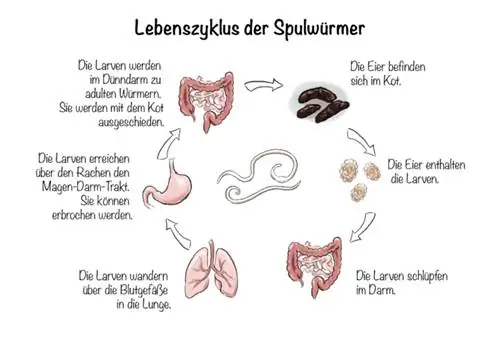
Remove raccoon droppings
If you find raccoon droppings in the garden or attic, you should thoroughly clean the toilet areas. It is important that you protect yourself from possible infection with roundworms. The more thorough you are when cleaning, the longer the success will last. This also includes follow-up.
There is an increased risk of roundworm infection when cleaning latrines.
Procedure:
- Put on rubber gloves and face mask
- Sweep out extensive latrine areas or clean them with a powerful vacuum cleaner
- pick up isolated piles with kitchen roll
- Put leftovers in a garbage bag and close it tightly
Protecting your hands is the top priority when cleaning latrines. In this way you reduce the risk of a smear infection with roundworms. Persistent eggs may be present in dried feces and spread through dust particles in the air. Wear a protective mask to prevent inhaling contaminated dust particles.
Tip
Clean the soles of your shoes after work so that you don't spread germs or bring them into your home.
Remove traces of urine
The urine penetrates deeply into the wood, making cleaning particularly time-consuming. Conventional means of odor control are usually not enough because the odors are masked, but the cause still exists. Many pet owners have had good experiences with the product “BactoDess (€15.00 at Amazon)”, which is based on the activity of microorganisms.
Important ingredients of BactoDess:
- Water, fatty alcohol and alcohol
- Fragrances: Benzyl Salicylate
- Benzisothiazolinone, Methylchloroisothiazolione and Methylisothiazolinone
The microscopic creatures break down organic substances and contribute to their decomposition, so that the cause of the odor is eliminated. A disadvantage is the comparatively long exposure time. A cheaper alternative is the all-purpose cleaner “Green Devil”, which is enzyme-based.
Application
The product is used like a cleaning agent. To treat established odor sources, the area must be thoroughly cleaned before the initial treatment. A 1:1 dilution with water is recommended. Then spray the surfaces or pour the product generously onto the surface. Additional moistening of wooden floors is necessary if the urine has already been deeply absorbed.
Follow-up
Clean the latrine with boiling water or, if possible, by flaming it. Roundworm eggs are resistant to high temperatures and only die at temperatures above 62 degrees. By treating surrounding surfaces with a disinfectant, you reduce pathogenic bacteria and viruses. Changing your gloves regularly ensures that you do not contaminate objects and work utensils during more complex cleaning work.
- shower after major activities
- wash your hands thoroughly after minor cleaning measures
- Clean worn clothing with boiled laundry if possible
How to Keep Raccoons Out of the Attic

What keeps moths away, raccoons can't stand either
Using fine scents, the animals find the old latrine area again, even if it has been thoroughly cleaned. This means that you may find raccoon droppings in the same place again a short time after cleaning. To prevent this, you must spread intensely smelling fragrances on the surfaces and renew them regularly:
- Spray an aqueous solution of pepper or chili powder
- use essential oils such as mint or eucalyptus oil
- Hanging mothballs
Tip
Scented tokens are also distributed outside the latrine. To keep raccoons out of the attic permanently, you should close all access points and protect the outside walls with smooth surfaces.
Frequently asked questions
Why do raccoons come to town?
Similar to blackbirds, hedgehogs or foxes, raccoons benefit from the living conditions in the city. Here they find food in abundance, provided by humans. There are numerous hiding places in unused attics, which act as winter quarters, resting places and places to raise young. The mammals reach their hiding places via downpipes and gutters, adjacent trees or green facades.
Rich meal plan:
- easy-to-reach earthworms on short-mown lawns
- neglected fruit trees on old orchards
- Food leftovers in garbage cans and compost heaps
How do raccoons live?
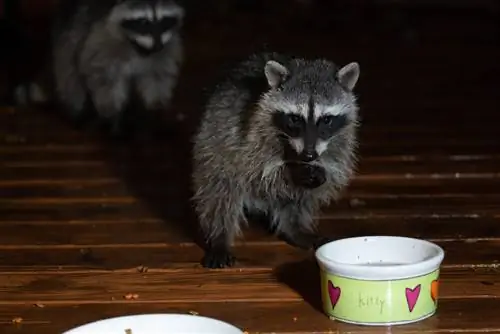
Raccoons are more active at night
The small bears are active during dusk and at night. In natural environments they seek shelter in tree hollows. Roof trusses and garden sheds in residential areas serve as alternative hiding places for the cultural follower. The mating season begins in January and lasts until March. Young animals are born between April and May. They stay with their mother until the next reproductive period before moving on to new territories. From November onwards the animals retreat for hibernation.
Does the raccoon have natural enemies?
Since there are hardly any large predators in Europe, the raccoon is comparatively safe here and can spread unhindered. Viruses and bacteria represent the greatest dangers for new residents. Epidemics can occur, causing populations to plummet. However, due to their high reproduction rate, raccoons are able to compensate for losses within a short period of time.
Do hunting measures against raccoons help?
It is of no use to capture or even kill animals on your own property. If a raccoon colony has developed in the area, new animals will continue to move in. It is therefore more effective to make your own garden as unattractive as possible for the small bears. Scare away unwanted visitors with scents, noise and light. For a long-term solution, you must eliminate all potential food sources and make hiding places inaccessible.
How old can a raccoon live?
The life expectancy of small bears is around 16 years. Natural factors ensure that the majority of wild animals only live a few years. There is a high mortality rate among young animals. About half of all raccoons born in a year die before their first birthday. The reasons for this are an early death of the mother or a lack of fat reserves in the first winter. For older animals, the annual death rate varies between ten and 30 percent. In Germany, the majority fall victim to road traffic or hunters. These factors reduce life expectancy to up to three years.

